
from the collection of
Allen Thomas Jr:
Loretta Lux, Isabella, 2001, Ilfochrome Print © Loretta Lux, Courtesy Yossi Milo Gallery, New York
by Allen Thomas Jr.
Allen Thomas Jr.’s photography collection is widely known. A Wilson native and part-time Raleigh resident, Thomas has had solo exhibitions of his collection at several museums, including Raleigh’s North Carolina Museum of Art and CAM, and has loaned work to more than 50 exhibitions worldwide. He serves on the boards of trustees of NCMA and CAM, where he was chairman until recently. Walter asked Thomas to tell us how he came to collect photography. “I have never taken an art history class in my life and do not believe anyone possesses a ‘good eye,’” he said. “I collect with my gut and my budget.” Here is his story.
For as long as I can remember, I’ve been a collector.
My father always referred to me as a pack rat. It started in fourth grade when my school had a paper sale. For a nickel you could get a neatly bound pad of colored paper in various sizes. I bet I spent five dollars! I had no need for all that rag, but I felt good knowing I had it.
My next collections included Wacky Wafer trading cards, Zoom Magazine editions, dinosaur stamps, wheat pennies, hotel soaps, and one collection that continues to this day: T-shirts. I’m unable to articulate what it feels like when disparate items are culled together to make a new whole, but for me, there is some sort of creative satisfaction.
While I have always felt the urge to create, it didn’t take long to figure out I lacked the one thing needed to be a successful artist, and that was talent. During my first few years as an undergraduate at Appalachian State University and later at UNC-Wilmington, I attempted media from pottery to leatherworks to intaglio printing – with disastrous results.
Ultimately, I would spend most of my class time talking with the talented students. People with natural artistic abilities fascinate me, and I would gravitate to those I thought were serious in their crafts. Ultimately, I started asking if I could purchase their pieces, and thus an art collection began. To this day I have four or five of those first acquisitions still on the wall.
After college, I moved back to my hometown of Wilson. My family of lawyers was in need of a firm manager, and I took the position at Thomas & Farris, PA in 1988 (a job I still hold 25 years later). For all that time, I have had complete support for the exhibitions and projects I’ve been lucky to be involved with. From art research to curating shows to serving on boards – it all takes time away from my “real” job, and having my family understand the draw of my passion is ultimately how I’ve been able to stay active.

from the collection of Allen Thomas Jr: © 2013, Erwin Olaf, The Boxing School, 2005. Courtesy of Hasted Kraeutler Gallery, NYC
Discovering photography
In the early ’90s, I traveled to New York City a dozen times a year looking for art. I had a few terrible experiences, which I will attribute to my Eastern North Carolina accent and penchant for jeans and T-shirts, but ultimately I discovered that the haughty attitude associated with the larger galleries did not trickle down to their smaller counterparts.
On a trip to New Orleans in 1993, I stumbled into A Gallery for Fine Photography on Royal Street. It was the first place I’d visited dedicated to photography, and the owner kept me for three hours. My earlier thoughts on photography as a serious art form had been limited.
I found myself mesmerized by images (mostly black and white gelatin prints) this gallery had on display. Dumbstruck might be a better description. Almost overnight, a passion for photography was ignited, and I left New Orleans with an armful of images.
In 1995, the New York gallery owner Julie Saul and I became good friends. She was, and is, a true mentor when it came to searching out quality images at a good price.
For the next several years, I immersed myself in contemporary photography. Along with visits to New York, I added art fairs to my travel log. Imagine hundreds of galleries from all over the world under one roof, or in very close proximity. While many abhor art fairs for various reasons, I rather love them and find them incredibly helpful in keeping up with artists’ new work, and even trends in the market. And you meet the most fascinating people.
In 2004, at The Armory Show in New York, I found myself drawn to an enormous photograph by French photojournalist Luc Delahaye. The four-foot by eight-foot image showed a dead Taliban soldier in a ditch somewhere in Afghanistan. While there were no blatant wounds, the twist of his torso and unnatural placement of his arms told the story. It was a disturbing image that drew me back several times throughout the day.
On my final trip by the photograph, a gentleman walked up and introduced himself as Bill Hunt. “You clearly like this image,” he said, “would you like to know more about it?”
Ultimately, and unfortunately, I passed on the purchase of Taliban Soldier – but that short interaction in the middle of that fair turned into an incredible friendship that still runs strong today.
W.M. Hunt is one of the world’s greatest photography collectors. He lives in New York and over his lifetime has purchased thousands of photographs, all with one simple theme: The diverted eye. He and his collection travel the world, and his dance card is filled with speaking engagements and lectures.
So when I’m asked how to go about buying a photograph or how to start a collection, I tend to give them Bill’s advice to me from 2006: “Photography is unlike any other contemporary art form,” he told me. “Everyone in the 21st century, at least in the Western world, has the experience of having looked at millions of photographs. We see them all the time, and we know what a good photograph is. We are all experts. The way to collect is to buy a photograph and take it home. Look, react, and commit. If you’re burdened with worries about the photograph’s provenance, the photograph’s ‘greatness,’ the photograph’s price, etcetera, you may be missing the point. Pursue the experience that’s pleasurable. When you see an image that thrills you, you must have that piece in your life. Buy it, take it home, hang it on the wall, and live with it.”
He said something else particularly memorable: “I’ve come to understand my collection as a manifestation of my unconscious. Buying photographs has led me to on an amazingly personal journey and, curiously enough, it has been a tool for gaining an even stronger sense of myself. It is a completely symbiotic relationship: As I have grown, so has the collection, and vice versa.”
Truer words were never spoken. The more you collect, the more you realize that “manifestation of your unconscious.” What that says about my fascination with Delahaye’s image I will leave for therapy, but if you find a piece of art that speaks to you, that moves you, that makes you circle back to look at again and again – just get it.



